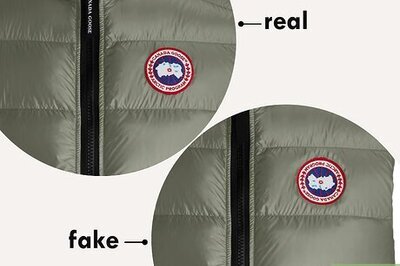
views
How to Tell if Almond Milk Is Bad
Examine the almond milk for changes in taste, smell, and appearance. While it’s generally easy to tell when cow’s milk has gone bad, signs of spoilage for almond milk (and similar products, like almond milk creamers and yogurt) can be a little more subtle. Here are some common signs to look out for: Sour taste (good almond milk has a subtle sweet and nutty flavor) Funky, sour, or stale odor (like wet cardboard or paint thinner) Thick, chunky texture after shaking (some separation is normal for almond milk, but if it separates immediately or stays chunky after shaking, it’s likely spoiled.) Darker color Swollen packaging or visible black mold (due to microbial growth)
How long does almond milk last?
Almond milk typically lasts 7-10 days after opening. Commercial almond milk is usually ultra-pasteurized, which extends its shelf life. It’s generally recommended to use refrigerated almond milk within 7 days of opening. If the milk is shelf-stable, meaning it doesn’t need to be refrigerated until you open it, it’s recommended to consume it within 7-10 days after opening. Unopened shelf-stable almond milk typically lasts 1-2 months. Remember to store shelf-stable almond milk in the fridge after you open it. Commercial almond milk will also come with an expiration or sell-by date, giving you a general timeframe on when to consume it. The sell-by date explains when a store should remove the item from the shelf, while an expiration date indicates when the product is potentially unsafe to consume. This timeframe is just a recommendation. Almond milk can sometimes still be safe to drink after 10 days. Just look for changes in texture, taste, and smell to know when to dispose of it. Homemade almond milk typically has a shorter shelf life of 5-7 days, as it usually contains no additives or preservatives.
How to Store Almond Milk
Store opened and unopened almond milk in the refrigerator. To give your almond milk the longest life possible, store it in the back of the fridge where the temperature is the coldest and steadiest. Avoid storing it at the front of the shelf or in the door, as this is where the temperature fluctuates the most. Some almond milk is shelf-stable, meaning it doesn’t need to be refrigerated until you open it. If you bought your almond milk unrefrigerated, it’s okay to keep it in your pantry until you open it. Then, store it in the fridge. If you don’t think you can drink your almond milk by its expiration date, another option is to freeze it. When stored in a freezer-safe container (not its original container), frozen almond milk can last up to 6 months. For example, portion your almond milk into ice cube trays, then freeze it to add to your coffee! After using almond milk, make sure the cap is properly sealed and return it to the fridge as soon as possible. Keep it out of the fridge no longer than two hours. Avoid drinking straight from the container so you don’t introduce bacteria to it.
What happens if you drink bad almond milk?
Drinking bad almond milk may cause digestive issues. While it’s possible to drink expired almond milk with no symptoms, if the milk has gone bad, you may experience nausea, vomiting, and/or diarrhea. In most cases, symptoms will resolve within 12-24 hours, but if you’re worried, call your poison center or see a doctor as soon as possible.
How to Tell if Other Milks Are Bad
Look for changes in texture, smell, and taste in other milks. In general, bad milk (no matter which type) will look, smell, and taste different. When milk expires, it usually develops a chunky consistency and a sour smell and taste. For more details, check out these articles: How to Tell if Milk is Bad How to Tell if Buttermilk is Bad How to Know When Oat Milk is Bad

















Comments
0 comment